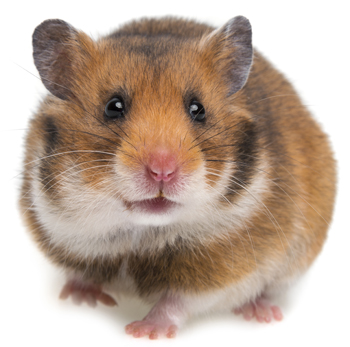Hamster grooming closeup

Photo courtesy of Depositphotos
Hamsters are intelligent and playful little guys. In the right situation can be affectionate pets, but aren’t always the best pets for children. They are commonly kept as pets, but are largely nocturnal and often nippy, especially if awakened. They have excellent hearing and sense of smell, but poor eyesight and are therefore prone to falling if left unattended on areas with ledges. In my opinion, hamsters are generally not appropriate pets for small children.
Most hamsters are best kept as solitary pets, particularly if they're Syrian hamsters, although occasionally bonded pairs may be compatible, particularly of the dwarf species.
Recommendations vary regarding size of hamster cages, but more space is better. One published study found the smaller the cage, the more stressed out the hamsters were. A single hamster should be housed in nothing smaller than a 20-gallon tank, but at least a 40-gallon tank would be better. Bedding should be deep and absorbent, but not made of wood-based materials. Recycled paper products such as CareFRESH brand bedding are ideal. Scooping out waste materials daily and changing the entire cage weekly will keep the environment healthy and minimize odors.
Hamsters prefer to have secluded areas in which to sleep, so plastic hideaways or things like flower pots laid on their side, are recommended for them to nest in. They will often take their treasured items into their nesting or sleeping areas. Paper towels are often a prized bedding material, and inexpensive and easy to replace when it becomes soiled.
As playful and intelligent creatures, they need items for environmental enrichment, such as solid wheels (not the wire wheels that can result in leg fractures) and toilet tissue cardboard rolls for exploration. Chew toys such as wood from apple trees and dog rawhides are popular. Daily handling is important both from a stimulation standpoint, but also to help keep them tame and make them a little more friendly.
Hamster urine has a strong smell, but if the cages are cleaned daily, this can be minimized. Cages should be large and well ventilated. Wire caging with narrow bars allows for good ventilation and prevents escape, but many people choose aquariums for safety reasons.
Average life expectancy for a pet hamster is approximately 18 months for the dwarf species, and up to 36 months for the Syrian species.
Diet
Although the hamsters would perhaps disagree, the staple diet should be made up of commercial pelleted rodent block, with all of the other items used just as occasional treats and snacks. This diet can be supplemented with small amounts of healthy people foods, such as fruit, vegetables, and pastas and so on, but those extras should be small in comparison to the primary staple of the rodent block. High-fat items such as nuts and seeds should largely be avoided, since they certainly can cause disease in hamsters over time. Also, avoid dried fruits and vegetables.
Remember though, any changes or any additions made to rodent diets should be done slowly to help avoid diarrhea, something that hamsters are certainly quite prone to.
Medical Issues
As a prey species, hamsters unfortunately tend to hide illness, so when illness is apparent to the owner, in reality they probably have been sick for an extended period of time. Most hamsters are significantly ill by the time they see a veterinarian. Keep in mind that hamsters are nocturnal and most clinic hours are during the day, resulting in a very grumpy patient.
Hamsters are capable of delivering a swift and painful bite, so it is always best to allow the animal to fully awaken prior to handling, and approach it slowly and gently. This goes for handling your pet at home and for your veterinarian.
Hamsters are prone to quite a number of diseases.
Bladder stones are not uncommon in hamsters. This often includes difficulty and pain on urination, frequent urination, and bloody urine. These stones may be felt by your veterinarian and can be visible on radiographs. The stones generally do not respond to dietary changes, Most commonly, however, bladder stones will require surgical removal.
Cardiac disease is a common condition, particularly in older female hamsters, and appears to be associated with amyloidosis in which amyloid proteins get into the organs and tissue, causing them to function incorrectly. Congestive heart failure, with secondary left atrial thrombosis, is the classic presentation. Clinically, the history includes weakness, lethargy, difficulty breathing, and occasionally sudden death. When first seen at the clinic, the hamster often has difficulty breathing, a rapid heart rate, and is bluish due to lack of oxygen. Treatment is palliative and aimed at symptomatic therapy, but is frequently unrewarding since congestive heart failure is often very advanced at the time of diagnosis.
One of the most common issues for hamsters is skin disease, which is not as common in hamsters as in many other pet rodent species. Be aware, though, of normal hairless (alopecia) patches, particularly over the flanks of male hamsters, which are called scent patches and are not lesions. Often the owner suddenly notices them and mistakes them for skin disease. When in doubt, look for symmetry within the patch—they are generally smooth and egg-shaped—and for a matching patch on the opposite side. Other than these false lesions, the next most common skin disease associated with hamsters is bite wounds.
Occasionally hamsters will develop ringworm, which can be diagnosed by a fungal culture. In addition to initiating other local or systemic therapy, it is important to look for other underlying causes of illness.
Golden hamster

Photo by Shutterstock
Most hamsters are not fond of living with or even spending time with other hamsters, and fighting is common. The resulting bite wounds generally respond to antibiotics, but occasionally surgery is necessary.
Lastly, cutaneous demodex infections are reasonably common in hamsters. Two types of demodex have been isolated from hamsters and increased incidence has been reported in males, older animals, and secondary to malnutrition or other ongoing disease. Dry, scaly skin and hairless skin are often seen over the back and rump, and denuded areas are often dry and scaly but not itchy. Other species of mites occasionally reported in hamsters include Sarcoptes, Notoedres, and various other rat mites and nasal mites. Notoedres may be causing dermatitis in the ears, face, feet, and tail. Diagnosis is made by identifying the mites and skin scrapings. Treatment is often with ivermectin or selamectin.
Lymphocytic choriomeningitis virus is a condition to be aware of due to its significant potential.to share it with other species, including people (zoonotic). In most instances it is not noticed in hamsters and many will clear the infection on their own. Others, however, will continue to shed large quantities of virus in the urine and be a source of human infection. This RNA arenavirus can cause a chronic wasting disease in hamsters, presenting with weight loss, decreased reproductive abilities, seizures, and depression. Diagnosis is based on pathology and serologic ELISA testing or IFA testing. There is no effective treatment, and infected animals are generally euthanized due to the high risk of zoonoses.
Many hamsters get diarrhea, and there are quite a few underlying potential causes. These are generally collectively referred to by owners as “wet tail,” and the differential diagnoses include Tyzzer's disease, which is caused by clostridium; salmonellosis; E. coli; antibiotic-associated enterocolitis, and intestinal parasites.
One of the most common underlying reasons is proliferative enteritis or ileitis (inflammations in the GI tract) seen in young hamsters shortly after transport to the pet store or to the new home, as well as older hamsters with other diseases. The causative agent for proliferative ileitis is a Lawsonia bacteria. Overgrowth of this bacterium is precipitated by recent transport, overcrowding, diet change, and stress. It is associated with sudden onset acute watery diarrhea, stomach pain, and dehydration, and is seen most commonly in younger animals and immunosuppressed or concurrently ill animals. There is typically a high rate of illness and death associated with the condition.
Treatment in the generic case of wet tail is generally supportive, and will usually include giving fluids and antibiotics. Prognosis is guarded for severely affected animals and older animals; those with an unclear underlying cause should be closely examined for concurrent diseases. This is a contagious process, so affected animals should be quarantined.
Cancer processes are common in older pet hamsters, with endocrine and alimentary tumors being the most prevalent, and adrenocortical adenomas being one of the more common. Adenomas are benign, but they can cause problematic side effects even they don't tend to spread elsewhere in the body. The most common malignant tumor associated with hamsters is lymphosarcoma. Older animals with lethargy, weight loss, dermatitis, and/or patchy alopecia should be screened for potential cutaneous lymphosarcoma. As with other species, some success with chemotherapy has been reported. A variety of other benign and malignant tumors can be seen. As with other species, a complete workup including biopsy is necessary to establish a diagnosis, prognosis, and treatment plan.
In the right environment and with the right people, hamsters make great pets as long as you provide proper nutrition and care.